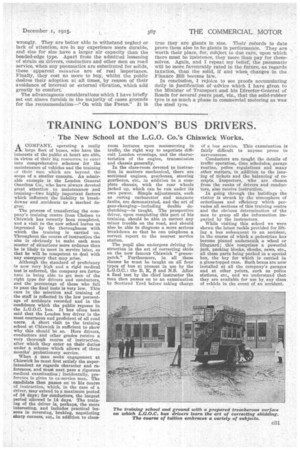.TRAINING LONDON'S BUS DRIVERS.
Page 15

If you've noticed an error in this article please click here to report it so we can fix it.
, The New School at the LGO. Co.'s Chiswick Works. '
ACOMPANY, operating a really large fleet of buses, who have the interests of the public at heart are able, in virtue of their big resources, to enter into comprehensive schemes for the maintenance of vehicles and the training of their men which are beyond the scope of a smaller concern. An admir
• able example is the London General Omnibus Co., who have always devoted great attention to maintenance and training—two highly important factors which influence the liability to breakdowns and accidents to a marked degree.
The process of transferring the company's training centre from Chelsea to Chiswick has recently been completed, and a visit to the new school leaves us impressed by the thoroughness with which the training is carried on. Throughout the course of instruction the aim is obviously to make each man master of situations more arduous than he is likely to meet in service later, so that he will be competent to deal with any emergency that•may arise.
Although the standard of proficiency is now very high and a rigid medical test is enforced, the company are fortunate in being able to get men of the right type for drivers and conductors, and the percentage of those who fail to pass the final tests is very low. This care in the selection and training of the staff is reflected in the low percentage of accidents recorded and in the confidence which the public reposes in the L.G.O.C. bus. It has often been said that the London bus driver is the most courteous and proficient of all road users. A short visit to the training school at Chiswick is sufficient to show why this should be so. Here drivers, conductors and other grades receive a very thorough course of instruction, after which they enter on their duties under a scheme which allows of three months' probationary service.
When a man seeks engagement at Chiswick he must first satisfy the superintendent as regards character and references, and must next pass a rigorous medical examination; incidentally, preference is given to ex-service men. The candidate then passes on to his course of instruction, which, in the case of a driver, may extend to a maximum period of 34 days; for conductors, the longest period allowed is 14 days. The training of the driver is, perhaps, the more interesting, and includes practical lessons in reversing, braking, negotiating sharp corners, etc., in addition to class
room lectures upon manceuvring in traffic, the right way to negotiate difficult London crossings, and the characteristics of the engine, transmission and chassis generally.
In the class-room devoted to instruction in matters mechanical, there are sectioned engines, gearboxes, steering gearboxes, etc., in addition to a complete chassis, with the rear wheels jacked up, which can be run under its own power. Simple adjustments, such as curing carburetter and magneto faults, are demonstrated, and the art of gear-changing—including double declutching—is taught. The prospective driver, upon completing this part of his training, should be able to correct any minor trouble on the road, and should also be able to diagnose a more serious breakdown so that he can telephone a correct report to the nearest service station.
The pupil also undergoes driving instruction in the art of correcting skids on the now famo0 Chiswick "greasepatch." Furthermore, in all these classes he must be taught on all four types of bus at present in use by the L.G.O.C.: the B, K, S and N.S. After a final test by the chief instructor the man then passes on to an examination by Scotland Yard before taking charge
of a bus service. This examination is fairly difficult to anyone prone to nervousness.
Conductors are taught the details of traffic operation, time schedules, garage routine, police regulations and many other matters, in addition to the issuing of tickets and the balancing of receipts. Inspectors, who are chosen from the ranks of drivers and conductors, also receive instruction.
In goin'g through the buildings the visitor is struck by the atmosphere of orderliness and efficiency which pervades all sections of this training centre and the obvious determination of the men to grasp all the information imparted by the instructors.
While visiting this school we were shown the latest tackle provided for lifting a bus subsequent to an accident, in the course of which a pedestrian has become pinned underneath a wheel or lifeguard ; this comprises a powerful jack, packing blocks, chocks, saws, etc., all these parts being packed in a special box, the key for which is carried in a glass-topped case. Such boxes are now installed at all the company's garages and at other points, such as police stations, etc., and we understand that they are available for use by any class of vehicle in the event of an accident.






























